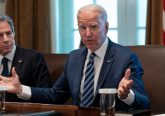As storm clouds gather on the horizon, the future of US support for Ukraine remains uncertain. Despite overall high levels of support among the American public, questions over how much money to commit to Ukraine and the looming uncertainty of the next US election cast doubt on the extent to which the US–the largest overall aid donor to Ukraine–can continue to provide support. Growing concerns about accountability and transparency raise further doubts about continuing such substantial support, especially with no end to the conflict in sight. Ultimately, in order to maintain the current level of US support for Ukraine, aid flows need to become institutionalised and predictable. This would allow for more strategic long-term planning on behalf of the US and its allies, reduce the uncertainty of next year and continue to best support the Ukrainian people.
US Domestic Support for Ukraine Wavering?
US and European support for Ukraine remains a vital lifeline to the war effort. Since Russia’s invasion of Ukraine in February 2022, the US has provided $43 billion (around £34.14 billion) in security assistance to Ukraine and a further $26 billion (nearly £21 billion) in direct financial aid. The most recent CNN-SSRS poll, conducted in July 2023, shows that for the first time a slim majority of Americans disapprove of the Biden administration’s overall handling of the Russian invasion of Ukraine. Although striking, some of this disapproval may come from supporters of Ukraine who feel that the Biden administration has not done enough or who would like to see further military intervention. The large number of Americans who continue to support the Ukrainian war effort is encouraging–despite it being over a year and a half into the conflict–but American coffers are not bottomless. Rather than providing financial assistance to Ukraine in dribs and drabs, the US should use the ongoing planning for the next fiscal year to lock in aid. It has become clear that a sustained effort is needed at the US institutional level to help Ukraine achieve victory and to demonstrate that acts of unilateral aggression will not be condoned.
Benefits of Institutionalising US Support for Ukraine
The current method of releasing aid to Ukraine in small and infrequent doses prevents long-term planning for the Ukrainians, the US, and its European partners. At a recent press conference, the EU’s High Representative for Foreign Affairs and Security Policy, Josep Borrell, openly questioned whether this approach is prolonging the conflict. Although US officials are careful not to escalate the conflict or get drawn into another protracted war–a deeply unpopular sentiment among Americans after Iraq and Afghanistan–the constant shifting of red lines has led some US policymakers to question whether there is an overarching plan for US support for Ukraine or whether it is reactionary.
Despite the allocation of resources and announcement of new weapons systems to be deployed in Ukraine, there is a considerable delay between their authorisation and their arrival on the frontlines. On January 25, 2023, President Biden pledged 31 Abrams tanks for Ukraine’s war effort. More than six months later, however, it appears that the first six to eight tanks will not arrive until September at the earliest. Denmark and the Netherlands announced on Ukraine’s Independence Day to provide F-16s, but do not expect to see them in action anytime soon as Ukrainian pilots still need to undergo extensive training. This training is set to begin in October in Arizona and could take five to eight months, depending on the expertise of the pilots. Logistics and maintenance training for ground support personnel will also take time. In order to bridge this gap between announcement and deployment on the battlefield, some degree of anticipation or pre-planning must be afforded through institutionalising support for Ukraine.
Next year will see numerous changes on both sides of the Atlantic, creating a significant degree of uncertainty. In addition to a major election in the United States in the autumn of 2024, the UK is also likely to hold a general election in the same timeframe. Adding to this uncertainty is the prospect of a new European Commission in the winter of 2024. Following the extension of Jens Stoltenberg’s mandate for another year at the NATO summit in July 2023, the alliance could also have a new Secretary General for the first time in a decade. At the centre of this uncertainty is the future of the United States. Last week the first clash among Republican candidates took place in Milwaukee, with many casting doubt about whether they would continue the Biden administration’s support for Ukraine. Two candidates, Vivek Ramaswamy and Ron DeSantis, vowed to cut off US aid to Ukraine entirely if elected. The frontrunner, former US President Donald Trump, was absent from this debate but, according to the latest RealClearPolitics poll, Biden and Trump are neck-and-neck. If elected, Trump claims he will freeze aid to Ukraine, potentially irrevocably altering the course of the conflict. With the war in Ukraine likely to continue, the scope and nature of US support for Ukraine will be a major debate as the election heats up. Two questions loom large: will US support for Ukraine wither under a change in administration and how will this impact the broader war effort?
Ultimately, supporting the Ukrainian people in their fight against unilateral aggression is and must remain a top foreign policy priority for the United States. Currently, the US boasts broad support for assisting Ukraine, both in the White House and in Congress. Now is the perfect time to do more to make this assistance routine and predictable, allowing for more planning and preparation so that every dollar sent to Ukraine goes further. National elections with global repercussions lay ahead next year, underscoring the urgency of making support for Ukraine as routine and standard as possible. No matter which administration is in power next year, support for Ukraine must continue. By institutionalising US support, Ukraine will have the resources and equipment it needs to repel Russia’s invasion and cement Ukraine’s standing in the West.







